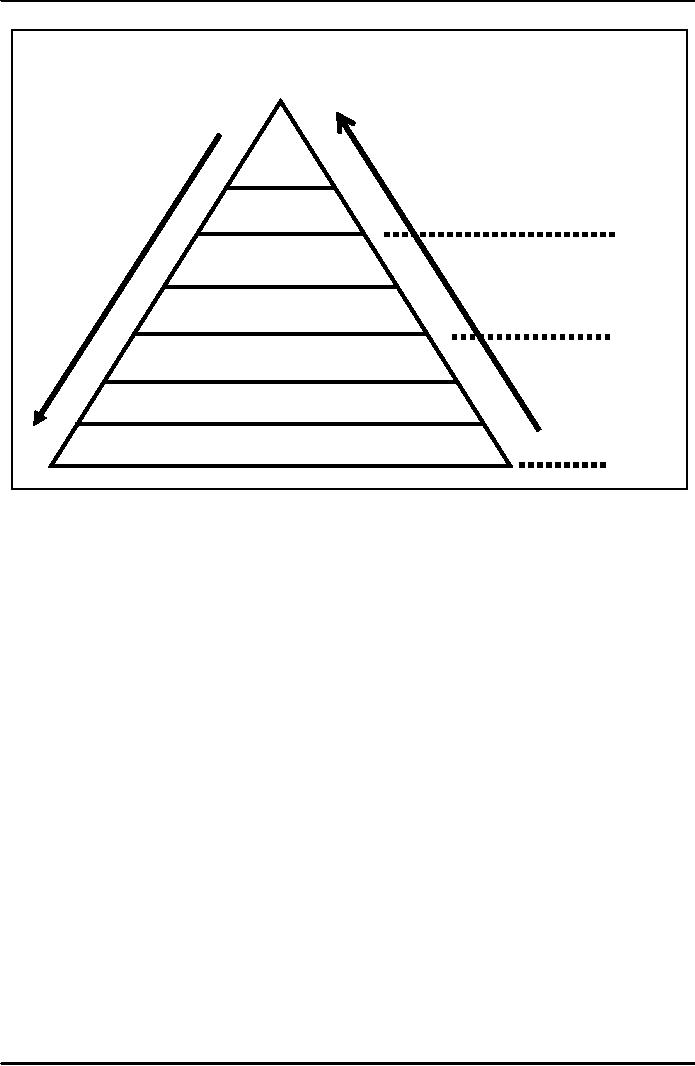 |
PLANNING – II:Planning ProcessThree principles of plans |
| << PLANNING – I:Four Major Aspects of Planning, Types of Plans |
| PLANNING COMMISSION AND PLANNING DEVELOPMENT:Functions, Approval Authority >> |

Introduction
To Public
AdministrationMGT111
VU
LESSON
19
PLANNING
II
At the
end of the lecture the students
will be able to
understand:
-
Remaining
types of plans
-
Discuss
the logical steps involved in planning
and see that this essentially is
a
rational
approach
to setting objectives
In
today's lecture will examine
remaining types of plans which
are:
7.
Programmes
Programmes
are a complex of goal, policies,
rules, tasks, procedures,
resources to be employed.
Programmes
have a time period and these
are for specific purpose.
Example: Rural Support Programmes,
Employees
Development Programme, Tawana Pakistan
Programme
8.
Budgets
Budget
is a statement of expected results
expressed in numerical terms. It is
referred to as a
`numberized'
plan. For private sector organization
financial operating budget is called a `profit
plan'.
For
public sector organization a budget of an organization
is an expression of income
and
expenditure.
It expresses the effectiveness of organization in
accomplishing its goals and
objectives. The
Federal,
Provincial and Districts Budgets
express the policies of respective
governments in providing
public
services.
Planning
Process
There
are eight steps in planning
process. These are:
1.
Recognizing
the need for
planning;
2.
Determining
the objectives;
3.
Forecasting
the future;
4.
Determining
alternatives
5.
Evaluating
Alternatives
6.
Selecting
a course of action
7.
Implementing
the plan
8.
Revising
the plan
1.
Recognizing the Need for
Planning
This
precedes planning and starts
with intention of either solving problem
or to attain some
objectives.
Organizations have need for
planning to use scarce
resources efficiently, and
make best use of
opportunities
and prepare for threats.
This is because plans are
considered as future course of action.
The
organizations
have to look ahead to solve
their problems.
2.
Determining Objectives
The
second step in the planning
process is establishing objectives
for the organization and then
for
each
subordinate/employee. Objectives specify
expected results and indicate
end point of what is to be
done
by the organization and by its
employees.
Objectives
are to be accomplished by the network of
strategies, policies, procedures,
rules, budget
and
programmes.
Example:
1.
To increase literacy by 5% from the
last year,
2.
To open schools in 5 villages of the
province
3.
To increase profits by 2%
All
the above are examples of
objectives.
69

Introduction
To Public
AdministrationMGT111
VU
3.
Forecasting the
future
Forecasting
is based on certain assumptions about the
future in which the plan is to be
carried out.
The
basis of forecasting is the understanding of
markets, the prices? what services
needs to be provided?,
what
technological change there will
be? What population changes
will there be?
Government
publishes documents like
`Economic Survey', State Bank of
Pakistan Report, Bureau
of
Statistics Census etc. used
by social scientists to forecast
economic and social trends
in the country.
4.
Determining Alternatives
This
involves examining alternative course of action. There
would hardly be a plan for
which
alternatives
do not exist.
Example:
What are the alternatives to
increase literacy? The
alternatives could be:
1.
To
open new schools or
2.
To
have more shifts in the existing
schools or
3.
To
ask the private sector to open
schools
The
government may adopt one of the
alternative or combination of
objectives.
5.
Evaluating Alternatives
Each
alternative is evaluated or examined in
terms of cost and benefits.
One course of action may
have
large investment and little benefits in
the short run. Other alternative may be
risky and have more
benefits/profits
Example:
1.
To
open new schools. This alternative
may require more money.
2.
To
have more shifts in the existing
schools. This alternative may be require
less money
compared
to alternative 1 because of use of existing
facilities.
3.
To
ask the private sector to open
schools. This alternative may not require
money from the
government
at all.
In
evaluation of alternatives the estimation of cost
and benefits is very important because on
its
basis
the decision is taken.
6.
Selecting one
Alternative
At
this point the decision has to be
taken to adopt an alternative from the
various alternatives.
The
choice
could be to pick one or more
than one alternatives, depending on the
emphasis on objectives to be
achieved
and the cost. At this stage the
plans are made part of the
budget. Budgets become means
of tying
up
the plans
7.
Implementing Plan
Implementation
of a plan is the most crucial
aspect. The implementation
determines whether the
plan
was able to achieve the
objectives or not.
8.
Revising plan
Planning
as Rational Process
As
indicated by the planning process, it is a
rational approach to accomplish
objectives. This
process
is illustrated in the following
graph:
70

Introduction
To Public
AdministrationMGT111
VU
The
Planning Process
Y
Assumptions
X
X1
t0
tn
t
-n
Time
In
this diagram progress (high
profits, more services etc.)
are shown on vertical axis
and time on
the
horizontal axis. X indicates
where we are (to) and y
where we want to be at future time (tn).
Often we
do
not have all the data
but we start planning and we
may start our planning at
x1. The arrows shown
around
the line X and Y are the
assumptions that we make
ability the future. When we
plan we are in fact
charting
an unknown territory. The
line XY is the decision path.
If
the future was completely certain the
line XY would be relatively easy to draw.
But since future is
uncertain
we make assumptions about
future.
Three
principles of plans
There
are three principles of the plan. These
are:
1.
Time
horizon: There are long term
and short term plans. The question is
how the long
term
plans can be coordinated with
long term plans? What is the
duration of plan?
These
questions
suggest multiple horizons of
plans.
2.
Commitment
Principle: The key to choosing
right planning periods seems
to be in
commitment
principle logical planning encompasses a
future period of time necessary
to
fulfil
series of action the commitment in decisions
made today
3.
Coordination
of short term and long term plans:
Often short term plans are
make without
reference
to long-range plans. There is a need to
integrate the short and long term
plans.
71

Introduction
To Public
AdministrationMGT111
VU
Figure
2
Hierarchy
of Objectives
Board
of Directors
Socio-
economic
Bottom
Up
Purpose
Top
management
Mission
Top
Down
Overall
objectives of
Middle
management
Organization
(strategic)
More
specific objectives
Division
Objectives
Lower
level Management
Department
or branch or unit
objectives
Individual
Objectives: 1. Performance, 2. Personal
objectives
In
figure 2 above is the hierarchy of
objectives, which are a kind
of plan, and provide guide
for
planning.
The objectives start from
the top of the organization and these
objectives are formulated by
the
Board
of Directors of the organization. These are
then translated into the
overall objectives of the
organization,
which in turn are made
more specific. Lower level
management objective are
performance
related
and personal development objectives. So
plans are formulated based
on the socio-economic purpose
of
the organization which is translated to the
lowest level.
Concepts:
Alternative
plans:
various
options that is
available.
Rational
process:
logical
sequential process of setting
goals and choosing on
best
goal.
Programme:
a
programme is a complex of goal, sub
task and resource.
72
Table of Contents:
- INTRODUCTION:Institutions of State, Individualism
- EVOLUTION OF PUBLIC ADMINISTRATION:Classical School, The Shovelling Experiment
- CLASSICAL SCHOOL OF THOUGHTS – I:Theory of Bureaucracy, Human Relation Approach
- CLASSICAL SCHOOL OF THOUGHTS – II:Contributors of This Approach
- HUMAN RELATIONS SCHOOLS:Behavioural School, System Schools
- POWER AND POLITICS:Conflict- as Positive and Negative, Reactions of Managers, Three Dimensional Typology
- HISTORY OF PUBLIC ADMINISTRATION – I:Moghul Period, British Period
- HISTORY OF PUBLIC ADMINISTRATION – II
- CIVIL SERVICE:What are the Functions Performed by the Government?
- CIVIL SERVICE REFORMS:Implementation of the Reforms, Categories of the Civil Service
- 1973 CONSTITUTION OF PAKISTAN:The Republic of Pakistan, Definition of the State
- STRUCTURE OF GOVERNMENT:Rules of Business, Conclusion
- PUBLIC AND PRIVATE ADMINISTRATION:The Public Interest, Ambiguity, Less Efficient
- ORGANIZATION:Formal Organizations, Departmentalization
- DEPARTMENTALIZATION:Departmentalization by Enterprise Function, Departments by Product
- POWER AND AUTHORITY:Nature of Relationship, Delegation of Functional Authority
- DELEGATION OF AUTHORITY:The Art of Delegation, Coordination
- PLANNING – I:Four Major Aspects of Planning, Types of Plans
- PLANNING – II:Planning ProcessThree principles of plans
- PLANNING COMMISSION AND PLANNING DEVELOPMENT:Functions, Approval Authority
- DECISION MAKING:Theories on Decision Making, Steps in Rational Decision Making
- HUMAN RESOURCE MANAGEMENT (HRM):Importance of Human Resource, Recruitment
- SELECTION PROCESS AND TRAINING:Levels at Which Selection takes Place, Training and Development
- PERFORMANCE APPRAISAL:Formal Appraisals, Informal Appraisals
- SELECTION AND TRAINING AND PUBLIC ORGANIZATIONS:Performance Evaluation,
- PUBLIC FINANCE:Background, Components of Public Finance, Dissimilarities
- BUDGET:Components of Public Income, Use of Taxes, Types of Taxation
- PUBLIC BUDGET:Incremental Budget, Annual Budget Statement, Budget Preparation
- NATIONAL FINANCE COMMISSION:Fiscal Federalism Defined, Multiple Criteria
- ADMINISTRATIVE CONTROL:Types of Accountability, Internal Control, External Control
- AUDIT:Economy, Effectiveness, Objectives of Performance Audit, Concepts
- MOTIVATION:Assumptions about Motivation, Early ViewsThree Needs
- MOTIVATION AND LEADERSHIP:Reinforcement Theory, Leadership, The Trait Approach
- LEADERSHIP:Contingency Approaches, Personal Characteristics of Employees
- TEAM – I:Formal & Informal teams, Functions of Informal Groups, Characteristics of Teams
- TEAM – II:Team Cohesiveness, Four ways to Cohesiveness, Communication
- COMMUNICATION – I:Types of Communication, How to Improve Communication
- COMMUNICATION – II:Factors in Organizational Communication, Negotiating To Manage Conflicts
- DISTRICT ADMINISTRATION:The British Period, After Independence, The Issues
- DEVOLUTION PLAN – I:Country Information, Tiers or Level of Government
- DEVOLUTION PLAN – II:Aim of Devolution Plan, Administrative Reforms, Separation of powers
- POLITICAL REFORMS:District, Tehsil, Functions of Union Council, Fiscal Reforms
- NEW PUBLIC MANAGEMENT (NPM):Strategy, Beginning of Management Approach
- MANAGERIAL PROGRAMME AGENDA – I
- MANAGERIAL PROGRAMME AGENDA – II:Theoretical Bases of Management, Critique on Management